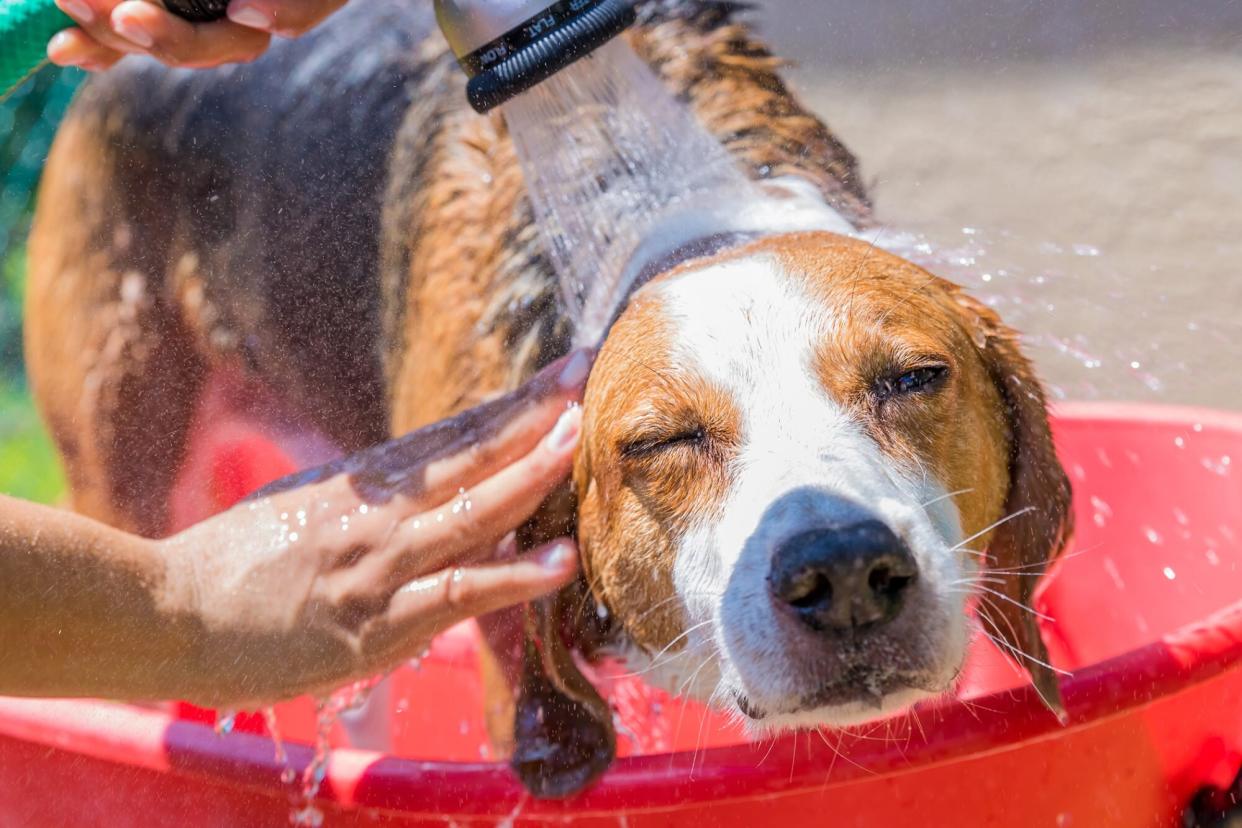Dog Heat Rash: A Red-Hot Problem in the Summer

Ryan / Getty
TABLE OF CONTENTS
On This Page
Can Dogs Get Heat Rash?
Signs
Diagnosing
Treatment
Prevention
The summer beckons outdoor playtime with your dog. However, too much heat spells trouble for a dog's skin and could lead to dog heat rash.
Unlike people, dogs don't sweat the same way to cool off; instead, they pant. And hot temperatures become dangerous when panting becomes ineffective. A dog that can't cool off is at risk for heat exhaustion and heatstroke, both of which need immediate veterinary care.
Not being able to cool off can also lead to a heat rash that needs to be quickly resolved before it worsens and causes your pup additional discomfort. Here's everything to know about treating and preventing a heat rash in your dog.
Can Dogs Get Heat Rash?
Absolutely! Hot and humid weather creates the perfect situation for a heat rash to develop. Dogs that live in tropical climates are especially prone to heat rashes.
Dogs that have skin folds, like pugs and shar peis, are also at risk for heat rashes, as these skin folds trap heat and moisture.
Signs of Heat Rash on a Dog
Heat rashes in dogs tend to occur on the body where the skin is soft and sensitive and hair is scarce. The belly is a common spot for heat rashes, along with the armpits, groin, and skin folds.
Below are the common signs of heat rash in dogs:
Redness
Tender skin
Persistent scratching and licking of affected skin
Boils, small pimples, pustules, bumps
Scabs
Sores
Foul skin odor
Bleeding
Be aware that the symptoms listed above are not specific to heat rash; other skin diseases can have these symptoms. However, if your dog has been in hot and humid weather, heat rash could be the culprit of your dog's skin problems.
RELATED: Help, My Dog Won't Stop Licking! What To Do About Hot Spots
Diagnosing Heat Rash in Dogs
It may be tempting to start treating your dog's heat rash right away. However, doing so without first talking to your veterinarian could make things worse.
If your dog has developed a rash after being outside in hot weather, take your dog to your vet. During the physical exam, your vet will pay close attention to the rash and ask you about your dog's heat exposure.
After the physical exam, your vet may take an impression smear of the rash (pressing a microscope slide gently against the affected skin) and examine it under a microscope. Heat rashes can quickly become infected with bacteria, so your vet will look for lots of white blood cells on the slide that would indicate an infection.
Once your vet has confirmed the heat rash, they will recommend proper treatment.
Dog Heat Rash Treatment and Home Remedies
Fortunately, heat rash in dogs can often be treated at home. Here are some common home remedies for heat rashes.
Hydrocortisone Cream
Hydrocortisone cream reduces skin redness and inflammation. Your vet will advise you on how to apply the cream to the rash and how often.
Aloe Vera
The gel of the aloe vera plant works wonders for soothing heat rash-irritated skin. Squeeze the gel directly from the plant if you can. If not, store-bought gels work, too.
Cold Towel
Of course, a cold towel placed on the rash will not heal the rash completely, but the cooling sensation will be a welcome relief for your dog.
Veterinary care is needed if a heat rash becomes infected. If this happens to your dog, your veterinarian will prescribe an antibiotic medication, either as a topical cream or pill. They might also prescribe a medicated shampoo that contains an antibiotic ingredient.
RELATED: Dog Won't Take Their Pills? Try These Vet-Approved Tricks for Giving Your Pets Their Medicine
To help prevent your dog from licking the cream or treatment off, you could use a cone or keep your dog distracted with tricks training, a food puzzle, or a frozen treat. Follow your vet's treatment instructions carefully to ensure that the heat rash and infection are healed.
How to Protect Your Dog from Getting Heat Rash in the Future
Heat rashes are no fun for your dog, and luckily it's easy to prevent them with these tips.
Avoid Direct Sun and Heat
During the summer, avoid being outside with your dog during the hottest parts of the day. Instead, take your dog out in the early morning and late afternoon rather than the middle of the day.
Keep Your Dog Cool
A quick spritz with cold water or a full-on cool-down with a water hose will help keep your dog from overheating on a hot, humid day. You could also let your dog play in a dog pool to stay cool.
Offer Shade
A shady spot will give your dog an area to rest and cool off. Their rest time in the shade also gives you the perfect opportunity to cool them down.
RELATED: How to Cool a Doghouse in the Dog Days of Summer
Monitor Your Dog
If your dog is panting a lot and looking tired, bring him inside. Offer him room temperature water while he's cooling off.
Heat rash in dogs is a common problem, especially during the summer. Remain vigilant when you're outside with your pup in the sun. If you notice the signs of heat rash, cool your dog down and contact your veterinarian for diagnosis and treatment.

